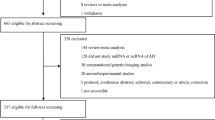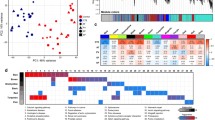Abstract
Background
Micro-RNA (miRs) targeting kinases and phosphatases regulate the hyper-phosphorylation of tau protein, which is a characteristic feature of Chronic Traumatic Encephalopathy (CTE).
Primary objective.
Identification of lead dysregulated miR expressed in CTE, and other similar tauopathies.
Methods
A search strategy was devised using the Preferred Reporting Items for Systematic Reviews and Meta-Analyses (PRISMA) guidelines to mine into multiple indexing databases such as Web of Science, Google Scholar, and PubMed spanning from 2005 to June 2022. Seven articles were screened out of 34,221 publications based on inclusion criteria and were categorized into two groups i.e., (1) CTE and its risk factors and (2) Age-related neurodegenerative disorders.
Results
Statistical analysis [RevMan 5.4.1] results showed that the overall risk ratio (RR) of the first group is significant (RR = 0.62, 95% CI = [0.38, 1.00], z = 1.95, p = 0.05) whereas, the second group favours the control population (RR = 1.64, 95% CI = [0.85, 3.16], z = 1.14, p = 0.14).
Conclusion
We observed that among all other dysregulated miRs, miR-181c-5p is significantly overexpressed in Alzhimers disease (AD) and CTE. Further, we found that miR-210-3p is also upregulated notably in all groups. In sum, we conclude that these miRs can be considered as potential target and biomarker in the diagnosis and treatment of various tauopathies.





Similar content being viewed by others
Data availability
The detailed methodology and dataset generated during the meta-analysis are available from the corresponding author upon reasonable request.
Code availability
Not applicable.
References
Batista-García-Ramó K, Fernández-Verdecia CI (2018) What we know about the brain structure-function relationship. Behav Sci (Basel) 8(4)
Kornienko VN, Pronin IN (2009) Neurodegenerative disorders of the central nervous system, in Diagnostic neuroradiology. Springer Berlin Heidelberg: Berlin, Heidelberg. p. 1075–1092. https://doi.org/10.1007/978-3-540-75653-8_14
Checkoway H, Lundin JI, Kelada SN (2011) Neurodegenerative diseases. IARC Sci Publ 163:407–419
Brown RC, Lockwood AH, Sonawane BR (2005) Neurodegenerative diseases: an overview of environmental risk factors. Environ Health Perspect 113(9):1250–1256
Abbott RD et al (2003) Environmental, life-style, and physical precursors of clinical Parkinson's disease: recent findings from the Honolulu-Asia Aging Study. J Neurol 250(3):30–9
Costanza A et al (2011) Review: Contact sport-related chronic traumatic encephalopathy in the elderly: clinical expression and structural substrates. Neuropathol Appl Neurobiol 37(6):570–584
Weiner MW et al (2013) Military risk factors for Alzheimer’s disease. Alzheimers Dement 9(4):445–451
Barth JT et al (2010) Acute battlefield assessment of concussion/mild TBI and return-to-duty evaluations. Military neuropsychology 127–174
McKee AC et al (2014) The neuropathology of sport. Acta Neuropathol 127(1):29–51
Montenigro PH et al (2015) Chronic traumatic encephalopathy: historical origins and current perspective. Annu Rev Clin Psychol 11:309–330
Omalu BI et al (2005) Chronic traumatic encephalopathy in a National Football League player. Neurosurgery 57(1):128–34 discussion 128–34
McKee AC et al (2013) The spectrum of disease in chronic traumatic encephalopathy. Brain 136(Pt 1):43–64
McKee AC (2020) The Neuropathology of Chronic Traumatic Encephalopathy: The Status of the Literature. Semin Neurol 40(4):359–369
Pierre K et al (2021) Chronic traumatic encephalopathy: update on current clinical diagnosis and management. Biomedicines 9(4)
Ganju A et al (2017) miRNA nanotherapeutics for cancer. Drug Discov Today 22(2):424–432
Weber JA et al (2010) The MicroRNA Spectrum in 12 Body Fluids. Clin Chem 56(11):1733–1741
Bhaskaran M, Mohan M (2014) MicroRNAs: history, biogenesis, and their evolving role in animal development and disease. Vet Pathol 51(4):759–774
Adlakha YK, Saini N (2014) Brain microRNAs and insights into biological functions and therapeutic potential of brain enriched miRNA-128. Mol Cancer 13(1):33
Radhakrishnan B, Alwin Prem Anand A (2016) Role of miRNA-9 in brain development. J Exp Neurosci 10:101–120
Cho KHT et al (2019) Emerging Roles of miRNAs in Brain Development and Perinatal Brain Injury. Front Physiol 10:227
Ma Q, Zhang L, Pearce WJ (2019) MicroRNAs in brain development and cerebrovascular pathophysiology. Am J Physiol Cell Physiol 317(1):C3-c19
Bartel DP (2004) MicroRNAs: genomics, biogenesis, mechanism, and function. Cell 116(2):281–297
Hwang HW, Mendell JT (2006) MicroRNAs in cell proliferation, cell death, and tumorigenesis. Br J Cancer 94(6):776–780
Baranwal S, Alahari SK (2010) miRNA control of tumor cell invasion and metastasis. Int J Cancer 126(6):1283–1290
Wu Y-Y, Kuo H-C (2020) Functional roles and networks of non-coding RNAs in the pathogenesis of neurodegenerative diseases. J Biomed Sci 27(1):49
Praticò D (2020) The functional role of microRNAs in the pathogenesis of tauopathy. Cells 9(10)
Gui Y et al (2015) Altered microRNA profiles in cerebrospinal fluid exosome in Parkinson disease and Alzheimer disease. Oncotarget 6(35)
Du W, Lei C, Dong Y (2021) MicroRNA-149 is downregulated in Alzheimer’s disease and inhibits β-amyloid accumulation and ameliorates neuronal viability through targeting BACE1. Genet Mol Biol 44(1):e20200064
Indrieri A et al (2020) The pervasive role of the miR-181 family in development, neurodegeneration, and cancer. Int J Mol Sci 21(6)
Kou X, Chen D, Chen N (2020) The Regulation of microRNAs in Alzheimer’s Disease. Front Neurol 11:288
Yuen SC et al (2021) Prediction of differentially expressed microRNAs in blood as potential biomarkers for Alzheimer’s disease by meta-analysis and adaptive boosting ensemble learning. Alzheimers Res Ther 13(1):126
Cao T, Zhen XC (2018) Dysregulation of miRNA and its potential therapeutic application in schizophrenia. CNS Neurosci Ther 24(7):586–597
Liu J et al (2022) The Biogenesis of miRNAs and Their Role in the Development of Amyotrophic Lateral Sclerosis. Cells 11(3)
Salemi M et al (202) Role and Dysregulation of miRNA in Patients with Parkinson's Disease. Int J Mol Sci 24(1)
Atif H, Hicks SD (2019) A Review of MicroRNA Biomarkers in Traumatic Brain Injury. J Exp Neurosci 13:1179069519832286
O'Brien J et al (2018) Overview of microRNA biogenesis, mechanisms of actions, and circulation. Front Endocrinol 9
Page MJ et al (2021) The PRISMA 2020 statement: an updated guideline for reporting systematic reviews. BMJ 372:n71
Stang A (2010) Critical evaluation of the Newcastle-Ottawa scale for the assessment of the quality of nonrandomized studies in meta-analyses. Eur J Epidemiol 25(9):603–605
Higgins JPT, GS ed (2011) Cochrane handbook for systematic reviews of interventions. Vol. 5.1.0. The Cochrane Collaboration
Sánchez-Meca J, Marín-Martínez F, Chacón-Moscoso S (2003) Effect-size indices for dichotomized outcomes in meta-analysis. Psychol Methods 8(4):448–467
Hall JA, Rosenthal R (2018) Choosing between random effects models in meta-analysis: Units of analysis and the generalizability of obtained results. Soc Pers Psychol Compass 12(10):e12414
Siedlecki-Wullich D et al (2019) Altered microRNAs related to synaptic function as potential plasma biomarkers for Alzheimer’s disease. Alzheimers Res Ther 11(1):46
Freischmidt A et al (2015) Serum microRNAs in sporadic amyotrophic lateral sclerosis. Neurobiol Aging 36(9):2660.e15–20. https://doi.org/10.1016/j.neurobiolaging.2015.06.003
Di Pietro V et al (2018) Salivary microRNAs: diagnostic markers of mild traumatic brain injury in contact-sport. Front Mole Neurosci 11
Lo TW et al (2021) Extracellular Vesicles in Serum and Central Nervous System Tissues Contain microRNA Signatures in Sporadic Amyotrophic Lateral Sclerosis. Front Mol Neurosci 14:739016
Alvia M et al (2022) MicroRNA Alterations in Chronic Traumatic Encephalopathy and Amyotrophic Lateral Sclerosis. Front Neurosci 16:855096
Toivonen JM et al (2014) MicroRNA-206: a potential circulating biomarker candidate for amyotrophic lateral sclerosis. PLoS ONE 9(2):e89065
Redell JB et al (2010) Human traumatic brain injury alters plasma microRNA levels. J Neurotrauma 27(12):2147–2156
McKee AC, Abdolmohammadi B, Stein TD (2018) Chapter 28 - The neuropathology of chronic traumatic encephalopathy, in Handbook of clinical neurology, Hainline B, Stern RA Editors Elsevier 297–307
Devoto C et al (2022) Remote blast-related mild traumatic brain injury is associated with differential expression of exosomal microRNAs identified in neurodegenerative and immunological processes. Brain Inj 36(5):652–661
Riolo G et al (2020) miRNA targets: from prediction tools to experimental validation. Methods Protoc 4(1)
Seok H et al (2016) MicroRNA Target Recognition: Insights from Transcriptome-Wide Non-Canonical Interactions. Mol Cells 39(5):375–381
Rodrigo Medeiros DB-V, Frank LaFerla M (2011) The role of tau in Alzheimer’s disease and related disorders. CNS Neurosci Ther 17:514–524
Stelzer G, Rosen R, Plaschkes I, Zimmerman S, Twik M, Fishilevich S, Iny Stein T, Nudel R, Lieder I, Mazor Y, Kaplan S, Dahary, D, Warshawsky D, Guan - Golan Y, Kohn A, Rappaport N, Safran M, Lancet D (2016) The GeneCards Suite: From Gene Data Mining to Disease Genome Sequence Analyses. Curr Protoc Bioinformatics 54:1.30.1-1.30.33. https://doi.org/10.1002/cpbi.5. (PMID: 27322403 ; Citations: 2,262)
Ai J et al (2019) MicroRNA-181c suppresses growth and metastasis of hepatocellular carcinoma by modulating NCAPG. Cancer Manag Res 11:3455–3467
Catanzaro G et al (2017) Loss of miR-107, miR-181c and miR-29a-3p promote activation of notch2 signaling in pediatric high-grade gliomas (pHGGs). Int J Mol Sci 18(12)
Manzano-Crespo M, Atienza M, Cantero JL (2019) Lower serum expression of miR-181c-5p is associated with increased plasma levels of amyloid-beta 1–40 and cerebral vulnerability in normal aging. Translational Neurodegeneration 8(1):34
Sun P et al (2018) MicroRNA-based therapeutics in central nervous system injuries. J Cereb Blood Flow Metab 38(7):1125–1148
Moon JM, Xu L, Giffard RG (2013) Inhibition of microRNA-181 reduces forebrain ischemia-induced neuronal loss. J Cereb Blood Flow Metab 33(12):1976–1982
Swarbrick S et al (2019) Systematic Review of miRNA as Biomarkers in Alzheimer’s Disease. Mol Neurobiol 56(9):6156–6167
Svingos AM et al (2019) Exploratory study of sport-related concussion effects on peripheral micro-RNA expression. Brain Inj 33(4):1–7
Shultz SR et al (2022) Decrease in Plasma miR-27a and miR-221 After Concussion in Australian Football Players. Biomark Insights 17:11772719221081318
Rothstein HR, Sutton AJ, Borenstein M ed (2005) Publication bias in meta-analysis. Chichester: John Wiley & Sons, Ltd
Funding
The study was supported by DST-INSPIRE project (DST/INSPIRE/04/2019/002618, UGC-start-up grant (F.30–547/2021), UGC-JRF (Ref. No.: 210510135543) and Central University of Rajasthan.
Author information
Authors and Affiliations
Contributions
Harshita Tak: Idea generation, hypothesis formulation, methodology development and study design creation, data collection and scrutiny, statistical analysis, initial draft writing, and manuscript finalization. Arpan Chattopadhyay: Review and Editing. Dr Hemanth Naick B: Developing the idea, designing the hypothesis, securing funds, editing and revising. All persons who meet authorship criteria are listed as authors and all authors certify that they have approved the version of the manuscript to be published and take responsibility for the content of the manuscript.
Corresponding author
Ethics declarations
Ethics approval
Not applicable.
Consent to participate
Not applicable.
Consent to publish
Not applicable.
Conflict of interest
Authors declared no conflict of interest at any stage of the study.
Additional information
Publisher's Note
Springer Nature remains neutral with regard to jurisdictional claims in published maps and institutional affiliations.
Key points
• Treatment for chronic traumatic encephalopathy is limited to symptom management, and targeting tau hyper-phosphorylation and acetylation is a promising area of research.
• In the present study, it was observed that miR-181c-5p and miR-210-3p, which were upregulated, showed prominent expression levels in brain tissue, indicating a possible link between these specific miRNAs and tau protein translation.
• An analysis of multiple studies indicates that MiR-16 5p is often, raised in cases of CTE and concussion. On the other hand, miR 181c 5p and miR 210 3p are prevalent in individuals with CTE, ALS, AD, and MCI.
Supplementary Information
Below is the link to the electronic supplementary material.
Rights and permissions
Springer Nature or its licensor (e.g. a society or other partner) holds exclusive rights to this article under a publishing agreement with the author(s) or other rightsholder(s); author self-archiving of the accepted manuscript version of this article is solely governed by the terms of such publishing agreement and applicable law.
About this article
Cite this article
Tak, H., Chattopadhyay, A. & Banavath, H.N. A meta-analysis of differentially expressed circulatory micro-RNAs in chronic traumatic encephalopathy and other tauopathies: A significant role of miR-181c-5p. Ir J Med Sci 193, 999–1007 (2024). https://doi.org/10.1007/s11845-023-03469-5
Received:
Accepted:
Published:
Issue Date:
DOI: https://doi.org/10.1007/s11845-023-03469-5




